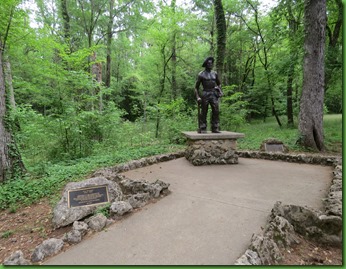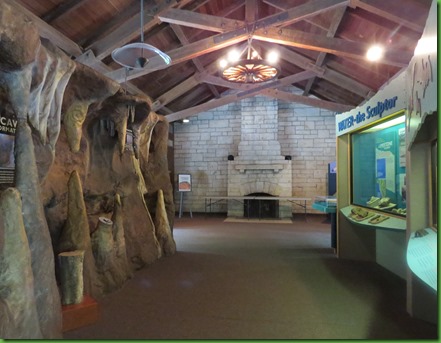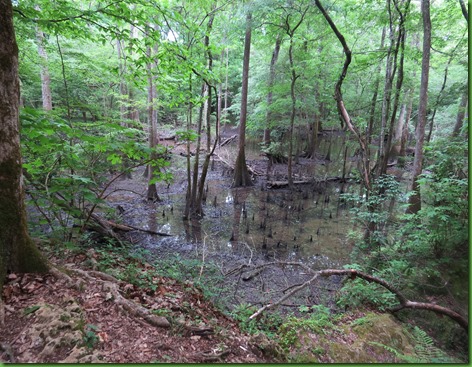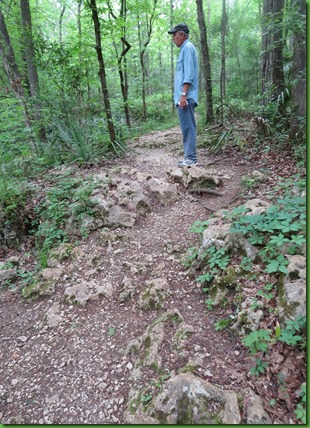Monday April 6, 2015
Florida Caverns State Park
Marianna, Florida
After breakfast today we bike over to the Visitor’s Center to see what we can learn about the park that we don’t already know and find out about the Cave Tours. Biking here is on the road but traffic is light and the road is lovely. It’s 2.5 miles to the Visitor’s Center and actually has a couple of hills. One of them requires some serious downshifting. Who would think of hills in flat Florida. North West Florida is a different place from the rest of the state.
At the foot of the path to the visitor center we find the CCC Statue dedicated to “:the young men of the Civilian Conservation Corps who developed and preserved the nation’s natural resources for the pleasure of future generations”. I know I’ve said it before but I seriously do not understand why we don’t bring this fabulous idea back as a way for young people to get experience and provide service to their country.
I’m so grateful for the pleasure their work gives us all over 70 years later.
The visitor center was built by the CCC into the side of the hill. It is built of local limestone stone. The back houses the restrooms and gift shop. The top floor is the Visitor Center. Steps on either end take you up there. We stop first in the gift shop and ask about the cave tours. They run every half hour Thursday through Monday, today. We decide we’ll check out the visitor center first and then come back for a tour.
The VC itself is lined on both sides with windows and flanked on both ends with stone fireplaces. The fireplace individual limestones are very interesting to look at closely as they almost seem to be carved and some have shell fossils in them.
The center has 3 nice short films and a number of interesting exhibits on the history of this park including pottery examples from the Chatot Indians who were occupying the land when the Spanish arrived. The examples span the period 1000-1650 AD.
Here we learn that the CCC also built the roads, trails, picnic shelter and the path and lighting in the cave itself. They labored by hand to to dig out paths and chisel tunnels through solid limestone. Workers who first crawled into the cave after its discovery in 1938 found a confusing mass of passages some less than 12” high. During this initial period, the Gopher Gang, as they were called, discovered a low room with deer skeletons and foot prints of Native Americans and black bears.
Here you can learn everything about the history, the flora and the fauna of the park. There are cool games and puzzles like David is doing. A very nice center in an historic building.
Here we find that this 1300 acre park is pretty amazing actually. It borders both banks of the Chipola River. It has an equestrian camp, swimming in the spring, kayaking in the river, two trail systems for hiking and a tour of the caverns. In addition, now listen up Bill, it has a 9 hole golf course and is part of the Florida Geocacheing Trail. Good thing we’ve planned our last 6 days before heading north here. Plenty of things to do.
We head back down to get cave tour tickets and see that there is a tour leaving right now and it is totally full, 25 people. We originally arrived at 9:00 and there were few people on that tour so we thought, no problem. Now we think perhaps we’d better come back for the first tour on Thursday for a smaller group.
We decide to hike the trails around the visitor center. The Bluff Trail and the Beach and Magnolia Trails. All totaled they are just over a mile. But you know how long that could take us.
We’ve just started down the Bluff Trail path off of the parking lot when these Indian Pinks stand out like bright crayons.
This trail goes through an upland hardwood forest which is among the rarest of native plant communities in Florida because most of the original hardwoods have been converted into farming or development. It occupies a narrow area between the floodplain forest and the higher elevation pinelands. This is a temperate, not tropical forest. Many species found here are northern species and found no where else in Florida. This area has higher elevations and cooler temperatures than most of Florida. It has 4 distinct seasons and most trees lose their leaves in winter. Tall hardwood trees act as a canopy with ground hugging wildflowers. Today we find wildflowers we have seen in the Appalachians near our farm. That surprises us.
We see this 3” long fella on one of the trees but have no idea who he is. Do you? Update #2: Heyduke commented to say this is an Eastern-eyed click beetle. I sure do learn a lot from my commenters. You guys are terrific! Thanks Heyduke.
Need some help on this one too. He’s clearly not a finch. Don’t think it’s a sparrow. It’s more than just a cute little brown bird I’m sure. Update #1: Page’s comment below lets me know I should trust my instinct. With the mottled breast I was going to say thrush but I’m only familiar with the wood thrush and he’s much larger. Thanks Page. I LOVE my commenters!
We do learn a new tree today. The Spruce Pine. It is the least common of Florida’s pines and occurs only in northern Florida in hammock and bottomland forests. It is the most shade tolerant of the pines and the only one that will seed in under hardwood forests.
The forest is filled with tall southern magnolia, mockernut hickory and black walnut. Northern Florida is the southern most limit of the walnut’s range.
We find wildflowers with which we are familiar. The Atamasco Lily we first saw in O’Leno, is here in the forest along with a profusion of Wild Columbine, a friend from the Blue Ridge Mountains near the farm.
Then we come to the first of the caves. Actually this one might better be described as a rock shelter. They have found evidence of early native use of these. I am just amazed at the karst rock.
This trail has hills. Up and down we go. Nice. We haven’t been off the flat since fall.
Liverwort and friend. Did you know what it looked like?
We come to the tunnel cave. It is seriously dark in there and walking through to the light messes with your vision of where you are in the dark. Better for short people than tall ones.
We’re at the wrong end looking in.
I walk through and come out on the easier side. David walks around.
Here’s a flash picture near the end to show how tall it is. Not very.
I make it, and David does too. It just takes him longer since he has to be much more careful not to bump his head. Amazing how much cooler it is even in this tunnel cave.
Further along, it’s another cave.
Nope it’s a cave shelter. Can you see the karst rocks. They look eaten away, because they have been.
It’s for short folks too.
From here the trail takes us up to to the Bluffs. This area of the floodplain of the Chipola River is bordered by steep slopes and bluffs formed by the erosion of the floodwaters of the river over thousands of years.
As we walk along up here, I just can’t get over the karst landscape. I have never seen it so obvious. The rocks all look like misshapen swiss cheese. I love it. Geology is amazing.
What’s most amazing, what’s at my feet or what’s out over the edge of the bluffs?
We’re just walking along in all this glory when David sees this blue beauty and then another cave. This one is blocked off. No entry. They mean business.
Well we thought they meant business with the wire gate but then we came upon a huge wire fenced enclosure with barbed wire at the top. Looks like a prison. But they aren’t keeping people in, they are keeping people out. I hope you can see the fencing below. This isn’t a very good picture of it. The area fenced off is large but it’s actually pretty inconspicuous.
ENTRY PROHIBITED………………….VIOLATORS WILL BE PROSECUTED
What about peekers? Are they OK?
Like the other gated one, this is a protected bat cave. In case you can’t read the sign it says:
This cave is a critical roosting site of Florida’s endangered bat species.
These bats are intolerant of harassment and will abandon
the cave if subjected to human disturbance.
WARNING
Entry Prohibited. Unauthorized entry into this cave is a violation of State and Federal Law.
Violators will be subject to prosecution under this code that code some other code (my terms)
bottom line $1500 fine and one year in prison.
All righty then.
Those cavers must be hard nosed if they won’t leave the bats alone and the park has to go to these lengths to protect them. But I am sure happy they do. Bats are the number one predators of mosquitoes. Three cheers for bats who don’t fly into your hair by the way.
And speaking of things for which there should be hefty fines, how about carving your stupid name or initials into the bark of a tree. I offer up my apologies for my species and a hug to this disfigured beech tree.
Remember when we were up on the bluffs? Well now we’re down by the floodplain. Getting a close up look at this mysterious and mucky looking landscape. After heavy rains to the north, the Chipola River floods this low flat swamp. The tupelo, cypress, ash and other trees slow the flood waters and cause the soil, which has eroded from lands upstream, to be deposited here on the floor of the swamp. The floodplain swamp is nature’s filter and flood control.
Oh, another cave? Right on the trail?
But a closer view shows we just have to step over some muck to continue back up from the bottom of the floodplain.
This floodplain is just another example of how Nature has everything so well and beautifully worked out. Why in the world are we not yet smart enough to leave her alone to take care of doing things right. We need to imitate her not abuse her arrogantly thinking we can improve upon her.
We come to the end of the trail and reach a paved sidewalk and another hole in the rock. David goes to investigate.
Does he look a little hesitant?
Looks like he’s found the cave entrance. But no entry until you come with a ranger. Hope there is no fine for trying to open the door. Light on the subject provided by flash.
Rather than walk straight back to the visitor center we take a short trip on the Beech and Magnolia Trail where we find the National Champion Florida Elm. This tree is the largest Florida Elm that’s ever been measured. In 1995 it was 102 feet tall and 120 inches in circumference. Double hugs for this award winner.
Look at those roots holding on tight to the ground.
Also on this trail we find that we are just a little too late for our Blue Ridge mountain wildflower friends the bloodroot and trillium. These ephemerals have already bloomed and soon will disappear leaving no trace until next year, in March it looks like.
Few things say spring in the woods more than a fresh little fiddlehead just unfurling.
This has been a wonderful hike on really lovely trails that would be great to experience in each season in this northern Florida Park.
We haven’t seen under the ground yet but above ground is worth the trip in itself.




































































What a great place to explore! We will definitely have to make time to go there ourselves.
ReplyDeleteThe bird is a Thrush species, but I do not know which one. Looks like a Hermit Thrush, but too far south.
Further research leads me to believe might be a migrating Swainson's Thrush. http://www.allaboutbirds.org/guide/Swainsons_Thrush/id
ReplyDeleteI would like to do a slow journey through the panhandle one of these days. I was excited at having three nights here at Topsail Hill and of course, it's rained the entire time! Oh well. Next year!
ReplyDeleteColumbine blooming already! Mine just pushing its leaves up from the ground yesterday, but my daffodils finally put on a show.
ReplyDeleteI agree with the Swainson's Thrush as the most likely thrush and your "bug" is a Eastern-Eyed Click Beetle
ReplyDeleteMy dad physically didn't qualify for the military but he did join the CCC's.
ReplyDeleteHate, hate, hate seeing initials carved in trees. So sad.
ReplyDeleteParts of the panhandle are actually quite hilly, as is central Florida. which you discover while riding a bike. We did our first (and only!) century ride in Clermont, the Horrible Hundred, and the hills were brutal.
Just think of how many parks wouldn't exist today if it hadn't been for the CCC. Those young men did amazing things, and mostly by hand. I totally agree with you it would be great to have a program like that today. Get young kids out into nature, learn the value of hard work and enable them to realize there is more to life than what appears on their cell phones!
ReplyDeleteAnother great VC! I have friends who tease me about how excited I am to check them out all over the country :-) Can you really call 12" high a passage? Who passes through that? I love the little tunnel cave - my kind of cave if you can see light at both ends :-) I'm so glad you take your time on these excursions, even the short ones have so much to see! It is refreshing to see nature allowed to make her own boundaries and paths, and encouraging to see man protect something as complex as a bat cave. Eventually tree huggers will win the day :-)
ReplyDeleteI never understood carving initials in something either. I think the columbine is my favorite wild flower.
ReplyDeleteIt is so hard to identify brown birds. So many of them :) Lovely hike, can't believe all the caves there. Looking forward to the Florida panhandle again someday.
ReplyDeleteYou got Bill's attention;o)) May even get to that park one of these days. We really loved our time hiking in the North Florida state parks...very different from the rest of Florida!! Your hike was really wonderful and can't wait to see what you find under all that beauty!!
ReplyDeleteWhat a wonderful place for a hike.
ReplyDeleteAside from what the CCC built and the jobs it gave these people at a time they really needed it, one of the great legacies of it is that it broadened their horizons, got them out into the country and gave them a taste for travel and other places.
Totally agree about the CCC giving us so much and would be great to see it happen again. Our public lands are in such need of maintenance projects and so many people need jobs. What a great opportunity it would be for people to give back and acquire skills at the same time. Plus they'd learn not to carve their names in rocks and trees. Sheesh. That just pisses me off. But once again you've found a delightful park with nice trails and beautiful flowers. Looking forward to the cave tour. BTW, I've crawled through 12" passages.
ReplyDeleteSherry, I really like this hike and this area. This looks like trails I would really enjoy investigating with all the neat features. Love the caves, rocks, trees, and those beautiful flowers. I can't wait to see under ground!! That is a great VC. So glad you got up close and personal with those fireplace bricks. That is very cool that they have fossils in them. I would have had to examine everyone of them. Super post!
ReplyDeleteanother great day exploring a beautiful State Park. . .
ReplyDeleteI love seeing things the CCC built all those years ago, but it could never work now. Too much political red tape, protective laws, and so on. Back then we were in the Great Depression and most people had trouble just keeping food on their tables, and the small allowance given to the CCC's and the remainder of their salary sent to their families was a godsend to the people. It just wouldn't work that way today. Plus Roosevelt was a genius, the likes of which we haven't seen since, and probably won't see again.
ReplyDeleteI've got to ask my niece who lives in Jacksonville if she has ever been there. It is gorgeous and would be qorth the drive. Thanks for sharing.
ReplyDeleteI really enjoy that you're showing me so many places in Florida that I've never been to. You're giving us lots of ideas for next winter. The spring wildflowers are so gorgeous -- makes me think of our adventure together last year in the fields of pitcher plants. That was amazing. :-)
ReplyDeleteLots of tree hugging today! Wonderful.
ReplyDeleteHey Duke (John) also helped me identify a bug I saw in Seminole. And today I learned from that those red flaming flowers are Indian Pinks!
And yes the CCC left a great legacy for all of us to enjoy and appreciate their hardwork. Thanks for showing me another part of FL.
Those trees are impressive and I enjoy caves! I am glad they are protecting those bats - must have been some really thoughtless people around there - no doubt they are of the clan who defaces trees :( What is wrong with people?! The karst is so interesting - I remember my geology class at Haverford...most of the time no one really thinks about what is down under us that makes up the foundation of this amazing planet. Lovely flower finds - and, I remain in agreement with you about the CCC!!
ReplyDeleteSometimes it pays to be a shortie!
ReplyDelete